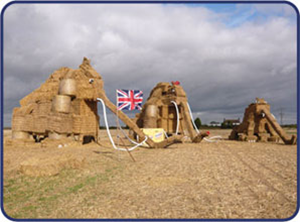For these guys, it started with Weeatabix.
Well, not really. Weeatabix is some kind of British cereal [and why is it that so many of the cereals from the olden days sound like some kind of mechanical invention or cleaning product? I mean, Weeatabix? Shreddies? Ruskets? I somehow imagine robots. But I digress. Badly.] that looks like hay bales, and as every company in the world seems to do, they had a contest — in this case, it was a straw (hay) bale contest, in support of British farming. £5000 went to the winning farm, and basically all they had to do was create art.
These mammoths are the winning design by farm folk Nikki and Paul Grant and David Sharpe, and were a big hit for obvious reasons. They won the money, and celebrated, I’m sure, and that will probably be a great story they can dine out on for years.
People frequently ask me how I come up with ideas for stories. Truthfully, it’s a question that gets posed to every author, and I will join the chorus in saying that I don’t really know. A lot of stuff churns through the subconscious and leaks out in dreams, but few of those ideas ever hold up to the rigorous light of day and the process of writing and revising (okay, that worked for Stephanie Meyers, but I’d have to ask what she’d been eating before going to bed). I have a suspicion that everyday life is what gives writers most of their fodder. Like Nikki Grant’s mother, who found the whole Weetabix art contest inspiring. She’s now written a children’s book about Mambo the Mammoth. (For obvious reasons he can’t be Manny, though he looks a lot like the Ice Age cartoon character.)
Mambo has a Facebook page, even.
Sometimes just being on the sidelines while something happens is enough to fan a creative spark. Wonder what that spark will be for you?
Some of the titles of the books just now on my coffee table/trunk: The Rebellious Century, 1830-1930, by Charles Tilly, The Arsenic Century: How Victorian Britain was poisoned at home, work, and play, by James C. Whorton, Healers and Healing in Early Modern Italy, by David Gentilcore, and on reserve Poison, detection, and the Victorian imagination, by Ian Blumney,
Oh, but this is way too much fun. If you can get your hands on a copy of The Arsenic Century, do. It’s one of the most engaging nonfiction reads I’ve dug into in awhile. Fun, fun, fun, and all in the name of work! Woot!
I love my job.

